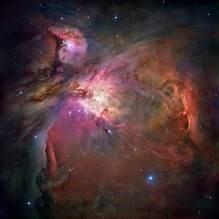Counting Stars - 6 to 14 February 2021
Can You Help to Count Stars?
Will you look to the sky between Saturday 6 to Sunday 14 February and help to count the number of stars you see in the constellation of Orion? This will help the CPRE (Campaign to Protect Rural England) to map how light pollution affects our view of the stars. Star Count is CPRE charity's annual survey of the nation's view of the night sky.
This is what Orion should look like:

If you look near the centre of Orion's prominent rectangle, there is a short diagonal line of three stars that forms Orion's Belt. Extending south from the belt, you'll see another, fainter line of stars that forms Orion's Sword. One of the objects in the sword isn't a star at all. It is M42, the Orion Nebula, which is a cloud of gas and dust that is like a giant fluorescent bulb.
M42 is part of a giant complex of clouds of interstellar gas and dust. Pockets of this material are collapsing to give birth to new stars. Hubble Space Telescope images reveal about 3,000 stars in the Orion Nebula alone, some of which could be as young as 10,000 years old.
Please click here to sign up for your free CPRE Star Count activity pack.
Dr Thomassen, Science


